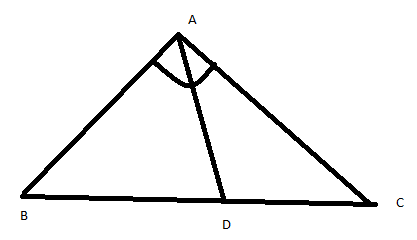
The vertices of the triangle are A(5,4,6), B(1,−1,3) and C(4,3,2). The internal bisector of angle A meets BC at D, then the length of AD is:
Answer
500.4k+ views
1 likes
Hint: This is the case of three dimensional coordinate geometry. First we will find the length of the sides AB and AC. Then find the coordinate of point D by using section formula. Using the distance formula length of AD can be easily computed.
Complete step-by-step answer:

In triangle ABC, the internal bisector of angle A will meet BC at D. As from the geometry, we know that any angle bisector in the triangle will bisect the opposite side in the ratio of the other two sides.
Thus, according to angle bisector theorem, we have
Distance formula for points
Since coordinates of A , B and C are (5,4,6), (1,−1,3) and (4,3,2). We will calculate lengths of AB and AC by using distance formula as follows.
Thus from equation (1) , we get
Now, point D will divide the BC in a ratio of 5:3.
So, by section formula,
Putting coordinates of B and C with m=5 and n=3 in above formula, we get
So coordinate of D is
Thus the length of AD will be
So, the correct answer is “Option B”.
Note: Proper use of formula in coordinate geometry is very important. Distance and section formulas are used in the above problem. Careful substitution of the values of coordinates and other terms is needed to get the correct result. Also, sometimes theorems from the geometry will be used appropriately to proceed in the solution.
Complete step-by-step answer:

In triangle ABC, the internal bisector of angle A will meet BC at D. As from the geometry, we know that any angle bisector in the triangle will bisect the opposite side in the ratio of the other two sides.
Thus, according to angle bisector theorem, we have
Distance formula for points
Since coordinates of A , B and C are (5,4,6), (1,−1,3) and (4,3,2). We will calculate lengths of AB and AC by using distance formula as follows.
Thus from equation (1) , we get
Now, point D will divide the BC in a ratio of 5:3.
So, by section formula,
Putting coordinates of B and C with m=5 and n=3 in above formula, we get
So coordinate of D is
Thus the length of AD will be
So, the correct answer is “Option B”.
Note: Proper use of formula in coordinate geometry is very important. Distance and section formulas are used in the above problem. Careful substitution of the values of coordinates and other terms is needed to get the correct result. Also, sometimes theorems from the geometry will be used appropriately to proceed in the solution.
Latest Vedantu courses for you
Grade 11 Science PCM | CBSE | SCHOOL | English
CBSE (2025-26)
School Full course for CBSE students
₹41,848 per year
Recently Updated Pages
Master Class 9 General Knowledge: Engaging Questions & Answers for Success

Master Class 9 English: Engaging Questions & Answers for Success

Master Class 9 Science: Engaging Questions & Answers for Success

Master Class 9 Social Science: Engaging Questions & Answers for Success

Master Class 9 Maths: Engaging Questions & Answers for Success

Class 9 Question and Answer - Your Ultimate Solutions Guide

Trending doubts
How many ounces are in 500 mL class 8 maths CBSE

Summary of the poem Where the Mind is Without Fear class 8 english CBSE

Advantages and disadvantages of science

10 slogans on organ donation class 8 english CBSE

The LCM and HCF of two rational numbers are equal Then class 8 maths CBSE

In Indian rupees 1 trillion is equal to how many c class 8 maths CBSE




